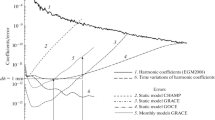Abstract
We presented the analysis results of the possibilities for increasing the spatial and temporal resolution of the existing models of the Earth’s gravitational field (EGF) by optimizing the orbital parameters (semi-major axis and inclination) of a constellation of spacecraft (SC) in a near-Earth orbit. As a result of numerical modeling, the spacecraft orbit elements were found. They cover 100% of the Earth’s surface over a 30-day interval with sub-satellite paths with an angular resolution of 1° × 1°, which is almost 4 times higher than the angular resolution of the monthly EGF models of the GRACE mission.







Similar content being viewed by others
REFERENCES
B. D. Tapley, S. Bettadpur, M. M. Watkins, and Ch. Reigber, Geophys. Res. Lett. 31, L09607 (2004).
J. C. Ries, R. Eanes, Zh. Kang, and U. Ko, Report No. CSR-16-02 (Center Space Res., Univ. Texas, Austin, 2018).
G. Heinzel, B. Sheard, N. Brause, K. Danzmann, et al., in Proceedings of the International Conference on Space Optics, ICSO 2012, Ed. by B. Cugny, E. Armandillo, and N. Karafolas, Proc. SPIE 10564, 1056420-1 (2012).
K. Abich, A. Abramovici, B. Amparan, A. Baatzsch, et al., Phys. Rev. Lett. 123, 031101 (2019).
F. Flechtner, K.-H. Neumayer, C. Dahle, H. Dobslaw, et al., in Remote Sensing and Water Resources, Ed. by A. Cazenave, N. Champollion, J. Benveniste, and J. Chen (Springer, Cham, 2016), p. 263.
G. Petit and B. Luzum, in IERS Technical Note No. 36 (Verlag des Bundesamts Kartogr. Geodas., Frankfurt am Main, 2010), p. 179.
M. V. Belikov and K. A. Taibatorov, Kinem. Fiz. Neb. Tel 6, 24 (1990).
O. Montenbruck and E. Gill, Satellite Orbits. Models, Methods, and Applications (Springer, Berlin, Heidelberg, 2000), Vol. 1, p. 371.
J. Kim and S. W. Lee, Acta Astronaut. 65, 1571 (2009).
V. K. Milyukov and Hsien-Chi Yeh, Astron. Rep. 62, 1003 (2018).
Funding
This work was carried out within the framework of the Interdisciplinary Scientific and Educational School of Moscow State University “Fundamental and Applied Space Research” and was supported by the Russian Foundation for Basic Research (project no. 19-29-11008).
Author information
Authors and Affiliations
Corresponding author
Additional information
Translated by E. Seifina
Rights and permissions
About this article
Cite this article
Milyukov, V.K., Filetkin, A.I. & Zhamkov, A.S. Ways for Improving the Accuracy of Measuring the Parameters of the Earth’s Gravitational Field Using an Orbital Spacecraft Constellation. Astron. Rep. 65, 331–341 (2021). https://doi.org/10.1134/S106377292104003X
Received:
Revised:
Accepted:
Published:
Issue Date:
DOI: https://doi.org/10.1134/S106377292104003X




